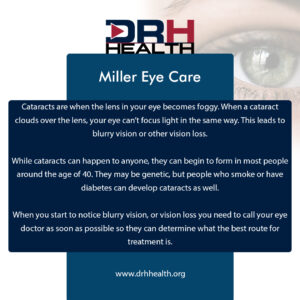Focusing on Your Eye Health – Cataracts
A cataract causes the clouding of the eye’s lens, making your vision blurry or less colorful. Some vision changes caused by a cataract may include seeing double, being extra sensitive to light, having trouble seeing well at night, and seeing bright colors as faded or yellow.
Age is the most common cause of cataracts. There is a tendency after the age of 40 for proteins in the eye’s lens to start to break down, which in turn causes the lens to become cloudy. Other reasons for cataracts may include:
- Family history
- Diabetes
- Smoking
- Sustained an eye injury
- A lot of time spent in the sun without wearing sunglasses
What are the types of cataracts?
- Age-related – 95% of cataracts are age-related, usually after age 40.
- Congenital – These are present at birth, usually caused by infection or inflammation during pregnancy.
- Traumatic – Lens damage from a hard blow, cut, puncture
- Secondary – Some medicines, eye disease, eye infections, or diseases such as diabetes cause these cataracts.
Cataracts typically form in both eyes, but not always at the same rate. They can develop slowly or quickly, or progress to a certain point, then not get any worse.
To determine if you have cataracts, your eye doctor will do a thorough eye exam:
- test your vision (visual acuity)
- test your side vision (peripheral vision)
- test your eye movement
- test you for glaucoma (by measuring the eye’s internal pressure)
- do a microscopic exam of the front of the eye (using an instrument called a slit lamp) to assess the density of the cataract and how it interferes with light passing through the lens
- widen (dilate) the pupils of your eyes to examine the retina, the optic nerve, and the macula (responsible for the best part of central vision)
- test you to see how glare affects your vision
After this exam, your eye doctor will determine whether you have cataracts, how much they interfere with your vision, whether surgery would help, and what treatment and lens replacements are best for you.
Cataracts are removed only with surgery. If your symptoms are not bothering you very much, you do not have to remove a cataract. A new eyeglass prescription may help you to see well. You should consider surgery when cataracts keep you from doing things you want or need to do.
The key to preventing vision loss is regular eye exams. If you are 65 or older, you should get a complete eye exam every one or two years, even if you have no problem seeing well.
Ronald Miller, MD
Ophthalmology
DRH Health – Miller Eye Care
